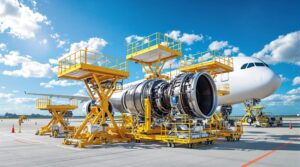Firstly, it’s essential to understand that pilot salaries vary widely depending on several factors. Experience plays a pivotal role in determining a pilot’s earning potential. Entry-level or junior pilots typically earn less than their seasoned counterparts. Airlines value experience as it correlates with a pilot’s proficiency and ability to handle diverse situations.
Another influential factor is the type of aircraft a pilot operates. Different aircraft require distinct skill sets, and accordingly, pilots are compensated differently. For instance, a pilot flying a jumbo jet might earn more than one operating a regional turboprop. The complexity and size of the aircraft contribute significantly to pilot compensation.
Geographical location also plays a substantial role in determining how much does an aircraft pilot make. Salaries can vary dramatically from one country to another. Developed nations with higher living costs generally offer more lucrative compensation packages for pilots. In contrast, pilots in less affluent regions might earn less, although the cost of living is typically lower.
Airline selection is yet another critical factor influencing pilot salaries. Major international carriers often provide more attractive remuneration packages compared to smaller, regional airlines. The prestige and reach of the airline, along with the demand for pilots, contribute to the overall compensation pilots receive.
Let’s break down the figures further with a glimpse at the approximate pilot salaries at different stages of their careers:
| Experience Level | Annual Salary Range |
|---|---|
| Entry-Level | $50,000 – $80,000 |
| Mid-Career | $80,000 – $120,000 |
| Experienced | $120,000 and above |
These figures are approximate and can vary based on the factors mentioned earlier. It’s crucial for aspiring pilots to consider these elements when contemplating a career in aviation. While the journey to becoming a pilot may require significant investment and dedication, the financial rewards can be substantial, making it a gratifying profession both in terms of passion and remuneration.
Aircraft pilot salary expectations across various industries
When considering a career as an aircraft pilot, one of the key aspects to explore is the salary expectations across various industries. Pilots play a critical role in the aviation sector, and their compensation can vary significantly based on several factors, including experience, the type of aircraft they operate, and the industry they work in.
In the commercial aviation sector, airline pilots are among the highest-paid professionals in the industry. The median annual salary for airline pilots, co-pilots, and flight engineers was $147,220 as of the latest available data. This figure, however, can vary based on the size of the airline, with pilots at major carriers generally earning higher salaries compared to those at regional airlines.
For those interested in a career in private aviation, such as corporate jet or private charter pilots, the salary landscape can differ. Private jet pilots often enjoy competitive salaries, and those flying for high-profile individuals or corporations can earn substantial compensation. The median annual salary for private jet pilots typically ranges from $75,000 to $150,000, depending on factors such as the size of the aircraft and the nature of the missions.
Helicopter pilots, operating in industries such as emergency medical services (EMS) or search and rescue, also have distinctive salary expectations. EMS helicopter pilots, for instance, may earn salaries ranging from $50,000 to $90,000 annually. Additionally, those involved in aerial firefighting or law enforcement aviation may have unique compensation structures based on the specialized nature of their roles.
The cargo and freight industry is another domain where pilots contribute significantly. Cargo pilots, responsible for transporting goods across the globe, earn varying salaries. The median annual salary for cargo pilots is around $80,000 to $120,000, with differences based on factors like the type of cargo, the size of the aircraft, and the employer.
Moreover, pilots in the general aviation sector, which includes activities such as flight instruction, aerial photography, and agricultural aviation, may experience diverse salary ranges. While entry-level positions in general aviation might have salaries in the range of $30,000 to $50,000, experienced pilots with specialized skills can command higher pay.
It’s essential to note that international opportunities can also impact pilot salaries. Pilots working for international airlines or flying internationally may receive additional compensation for the challenges associated with long-haul flights, different time zones, and diverse operating conditions.
Factors that affect an aircraft pilot’s salary
When it comes to determining an aircraft pilot’s salary, several crucial factors come into play. One of the primary contributors is Experience. Seasoned pilots often command higher salaries due to their accumulated flight hours and demonstrated proficiency. This proficiency is not solely measured in years but in the complexity of flights undertaken and the diversity of situations handled. An experienced pilot, adept at navigating various scenarios, tends to be more sought after, thus negotiating for a higher pay scale.
Another pivotal element is the Type of license held by the pilot. Different licenses allow for diverse operations and responsibilities. A higher-tier license, such as an Airline Transport Pilot License (ATPL), grants authorization to operate larger and more advanced aircraft, thereby influencing the salary bracket. This license not only opens doors to commanding bigger planes but also positions the pilot for leadership roles, often tied to better compensation.
The Type of aircraft operated also affects the salary. Pilots handling larger, technologically advanced aircraft typically earn more due to the increased skill and precision required. These aircraft demand specialized knowledge and expertise, contributing significantly to a pilot’s market value. Conversely, pilots managing smaller, less complex planes may receive comparatively lower salaries.
Moreover, the Type of operation the pilot is involved in plays a vital role. Commercial airlines, cargo transportation, aerial surveying, and medical evacuation represent various sectors within aviation, each with its unique demands and salary structures. For instance, airline pilots often receive stable salaries with additional perks like bonuses and benefits, while those involved in aerial surveying might encounter fluctuating incomes based on project availability and duration.
| Factors Affecting Pilot Salaries | Impact |
|---|---|
| Experience | Directly influences negotiation power |
| Type of license | Determines scope of aircraft and responsibilities |
| Type of aircraft | Directly correlates with expertise and complexity |
| Type of operation | Varies salary structures and stability |
How to become an aircraft pilot and necessary qualifications
To embark on the exhilarating journey of becoming an aircraft pilot, aspiring aviators must follow a structured path that involves acquiring the necessary qualifications. The first crucial step is enrolling in a reputable flight school, which serves as the launchpad for their aviation dreams.
Attaining the essential licenses is a cornerstone of a pilot’s career. The most fundamental license is the Private Pilot License (PPL), obtained after completing a comprehensive training program. This initial license allows pilots to fly for personal and recreational purposes. To progress further in their aviation careers, individuals pursue additional licenses and ratings.
As pilots ascend in their proficiency, obtaining an Instrument Rating (IR) becomes paramount. This qualification enables pilots to navigate and operate an aircraft solely by reference to instruments, a crucial skill in adverse weather conditions. It adds a layer of versatility to their capabilities, making them adept in various flying scenarios.
Accumulating sufficient flight hours is an indispensable aspect of a pilot’s journey. These hours, often logged during training and subsequent flying experiences, contribute to the mastery of skills and the development of a pilot’s judgment. The more flight hours a pilot accrues, the more seasoned and reliable they become in handling diverse flight situations.
Progressing to the next level involves obtaining a Commercial Pilot License (CPL). This advanced license opens doors to professional opportunities, allowing pilots to be compensated for their services. With a CPL, aviators can pursue a career in fields such as aerial photography, banner towing, or even flight instruction.
For those aspiring to operate larger and more complex aircraft, the Airline Transport Pilot License (ATPL) is the pinnacle. This license is the key to becoming a captain for major airlines, requiring a substantial number of flight hours and meeting rigorous standards set by aviation authorities.
Throughout this journey, pilots continually enhance their skills by obtaining various ratings, such as Multi-Engine Rating (MER) and Type Rating. These specialized ratings qualify pilots to operate specific types of aircraft, expanding their career possibilities.






